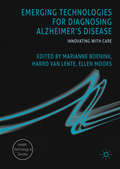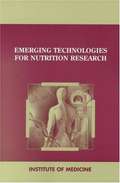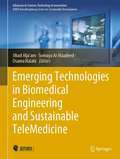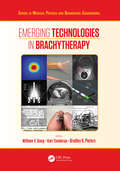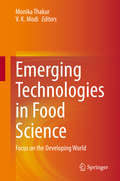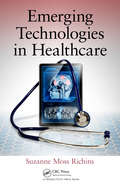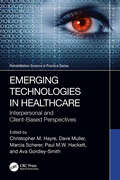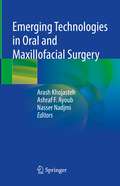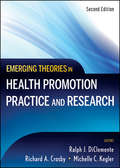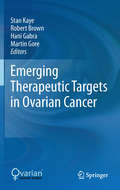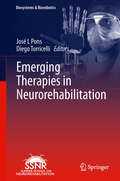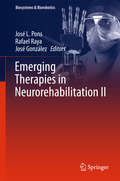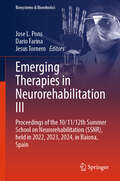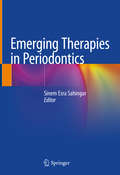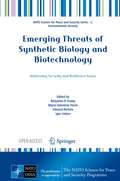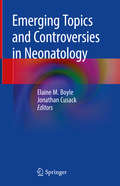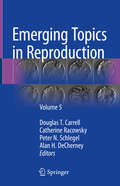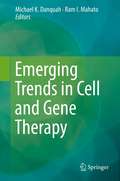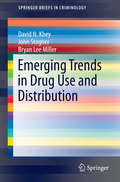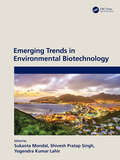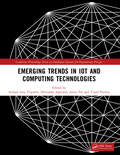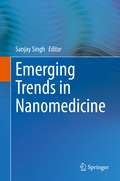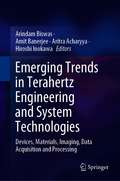- Table View
- List View
Emerging Technologies for Diagnosing Alzheimer's Disease
by Marianne Boenink Harro Van Lente Ellen MoorsThis book explores international biomedical research and development on the early diagnosis of Alzheimer's disease. It offers timely, multidisciplinary reflections on the social and ethical issues raised by promises of early diagnostics and asks under which conditions emerging diagnostic technologies can be considered a responsible innovation. The initial chapters in this edited volume provide an overview and a critical discussion of recent developments in biomedical research on Alzheimer's disease. Subsequent contributions explore the values at stake in current practices of dealing with Alzheimer's disease and dementia, both within and outside the biomedical domain. Novel diagnostic technologies for Alzheimer's disease emerge in a complex and shifting field, full of controversies. Innovating with care requires a precise mapping of how concepts, values and responsibilities are filled in through the confrontation of practices. In doing so, the volume offers a practice-based approach of responsible innovation that is also applicable to other fields of innovation.
Emerging Technologies for Nutrition Research: Potential for Assessing Military Performance Capability
by Committee on Military Nutrition ResearchThe latest of a series of publications based on workshops sponsored by the Committee on Military Nutrition Research, this book's focus on emerging technologies for nutrition research arose from a concern among scientists at the U.S. Army Research Institute of Environmental Medicine that traditional nutrition research, using standard techniques, centered more on complex issues of the maintenance or enhancement of performance, and might not be sufficiently substantive either to measure changes in performance or to predict the effects on performance of stresses soldiers commonly experience in operational environments. The committee's task was to identify and evaluate new technologies to determine whether they could help resolve important issues in military nutrition research. The book contains the committee's summary and recommendations as well as individually authored chapters based on presentations at a 1995 workshop. Other chapters cover techniques of body composition assessment, tracer techniques for the study of metabolism, ambulatory techniques for the determination of energy expenditure, molecular and cellular approaches to nutrition, the assessment of immune function, and functional and behavioral measures of nutritional status.
Emerging Technologies for the Analysis of Forensic Traces (Advanced Sciences and Technologies for Security Applications)
by Simona FranceseThis book provides a line of communication between academia and end users/practitioners to advance forensic science and boost its contribution to criminal investigations and court cases. By covering the state of the art of promising technologies for the analysis of trace evidence using a controlled vocabulary, this book targets the forensics community as well as, crucially, informing the end users on novel and potential forensic opportunities for the fight against crime. By reporting end users commentaries at the end of each chapter, the relevant academic community is provided with clear indications on where to direct further technological developments in order to meet the law requirements for operational deployment, as well as the specific needs of the end users. Promising chemistry based technologies and analytical techniques as well as techniques that have already shown to various degrees an operational character are covered. The majority of the techniques covered have imaging capabilities, that is the ability to visualize the distribution of the target molecules within the trace evidence recovered. This feature enhances intelligibility of the information making it also accessible to a lay audience such as that typically found with a court jury. Trace evidence discussed in this book include fingermarks, bodily fluids, hair, gunshot residues, soil, ink and questioned documents thus covering a wide range of possible evidence recovered at crime scenes.
Emerging Technologies in Biomedical Engineering and Sustainable TeleMedicine (Advances in Science, Technology & Innovation)
by Somaya Al-Maadeed Jihad Alja’am Osama HalabiThis book presents the most recent research and applications in Biomedical Engineering, electronic health and TeleMedicine. Top-scholars and research leaders in the field contributed to the book. It covers a broad range of applications including smart platforms like DietHub which connects patients with doctors online. The book highlights the advantages of Telemedicine to improve the healthcare services and how it can contribute to the homogenization of medicine without any geographical barriers. Telemedicine transforms local hospitals, with limited services, into a node of an integrated network. In this manner, these nodes start to play an important role in preventive medicine and in high-level management of chronic diseases. The authors also discuss the challenges related to “health informatics” and in “e-health management”. The topics of the book include: synchronous and asynchronous telemedicine with deep discussions on e-health applications, virtual medical assistance, real-time virtual visits, digital telepathology, home health monitoring, and medication adherence, wearable sensors, tele-monitoring hubs and sensors, Internet of Things, augmented and virtual reality as well as e-learning technologies. The scope of the book is quite unique particularly in terms of the application domains that it targets. It is a unique hub for the dissemination of state of the art research in the telemedicine field and healthcare ecosystems. The book is a reference for graduate students, doctors, and researchers to discover the most recent findings, and hence, it achieves breakthroughs and pushes the boundaries in the related fields.
Emerging Technologies in Brachytherapy (Series in Medical Physics and Biomedical Engineering)
by William Y. Song Kari Tanderup Bradley PietersBrachytherapy is continuously advancing. Years of accumulated experience have led to clinical evidence of its benefit in numerous clinical sites such as gynecological, prostate, breast, rectum, ocular, and many other cancers. Brachytherapy continues to expand in its scope of practice and complexity, driven by strong academic and commercial research, by advances in competing modalities, and due to the diversity in the political and economic landscape. It is a true challenge for practicing professionals and students to readily grasp the overarching trends of the field, especially of those technologies and innovative practices that are not yet established but are certainly on the rise. Addressing this challenge, Emerging Technologies in Brachytherapy presents a comprehensive collection of chapters on the latest trending/emerging technologies and expert opinions. It is divided into five broad sections: Section I: Physics of Brachytherapy Section II: Imaging for Brachytherapy Guidance Section III: Brachytherapy Suites Section IV: Is Brachytherapy a Competitive Modality? Section V: Vision 20/20: Industry Perspective Each section has a carefully selected collection of chapters, which covers the spectrum of topics in comprehensive detail. By drawing on recognized experts and key opinion leaders from academia and commercial sectors worldwide (100+ contributors), Emerging Technologies in Brachytherapy provides readers with a wealth of relevant information needed to comprehend the rapidly advancing technologies and trends of today and the prospects for the future.
Emerging Technologies in Food Science: Focus on the Developing World
by Monika Thakur V. K. ModiThis book provides a comprehensive review of recent innovations in food science that are being used to tackle the challenges of food safety, nutritional security and sustainability. With a major focus on developing nations, like India, the book is divided into four main sections. The first section provides an overview of the food industry, while the second explores food safety in various segments, with an interesting account of street food safety – an important, yet often neglected aspect for safety parameters. The third section, on nutritional security and sustainability, explores various ways of maximizing nutrition and optimizing waste management in the food industry. The book closes with a section on emerging technologies and innovations, which introduces readers to some of the latest technologies in the food industry, including advances in food processing, packaging, nanotechnology, etc. The topics have been divided into 25 different chapters, which offer a diverse blend of perspectives on innovations in the developing world. Ideally suited for students and researchers in the food sciences, the book is also an interesting read for industry experts in Food Science and Technology.
Emerging Technologies in Healthcare
by Suzanne Moss RichinsRecent changes in healthcare delivery as mandated by the Patient Protection and Affordable Care Act are forcing providers to focus on technology as a way to improve the health of the population, while engaging patients and encouraging them to take accountability for maintaining their own health. One way of doing this is through the use of mobile he
Emerging Technologies in Healthcare: Interpersonal and Client Based Perspectives (Rehabilitation Science in Practice Series)
by Christopher M. Hayre, Dave Muller, Marcia Scherer, Paul M.W. Hackett, and Ava Gordley-SmithThis edited book focuses on the role and use of emerging technologies within the healthcare sector. This text draws on expertise from leading practitioners and researchers who either utilize and/or are at the forefront of researching with emerging technology in anticipation of enhancing patient outcomes.Emerging Technologies in Healthcare: Interpersonal and Client-Based Perspectives focuses on the role of emerging technologies in society and how it may enhance medical treatment, management, and rehabilitation of service users. It offers expert perspectives on topics covering emerging technological advances and how they are being incorporated into healthcare, but also critically appraises forthcoming implementation. The editors draw from recent publications and the growing narrative surrounding technological advances, notably telerehabilitation, virtual reality, augmentation, and mHealth. Subsequent chapters focus on these, coupled with other emerging technologies, providing detailed insight into how these can either enhance and/or hinder patient/service user outcomes. Each chapter explores the multifaceted use and application of each emerging technology, that impacts on diagnosis, treatment, and (self-) management of individuals. For example, can emerging technology really facilitate patient diagnosis, improve, or remove practitioner–patient interactions, provide sound rehabilitation, and treat/monitor mental health conditions?This edited volume encompasses an array of emerging technologies that will remain pertinent to caregivers, families, practitioners, service users and policymakers. This is not a text on emerging technology alone but on its societal implications, accompanied by ethical, altruistic, and moral examples for such advances within the healthcare field. It is targeted that this text will enhance and offer original discussions surrounding the interconnectivity of technology and medicine, rehabilitation, and patient care.
Emerging Technologies in Oral and Maxillofacial Surgery
by Nasser Nadjmi Arash Khojasteh Ashraf F. AyoubThis book covers the application of emerging technologies, occurring after the 4th industrial revolution, in oral and maxillofacial surgery (OMFS) and introduces a new era of personalized medicine in this discipline. It describes the manufacturing and data acquisition methods, in detail, including the advantages and disadvantages of each process. The workflow of using the emerging technologies in reconstructive treatments, orthognathic surgery, implant dentistry, robotic surgery and bio‑fabrication have been covered in separate chapters.Several related cases in conjunction with the workflow are presented and discussed as clinical examples of each, for practical discussion of the workflow and process trajectory. Each chapters provides introduction, definition, application and plausible pitfalls of employing these technologies in specific areas. Given the multiple materials and techniques, the logic behind selection of each in different fields of practice and thorough explanation of process provides surgeons with a background on how and why a certain approach is employed, and if application of emerging technologies would outdo traditional treatment processes. The importance of fabricating living tissues is discussed as one of the most recent progresses in the field. The bench-to-bedside transition, their clinical application, and their remarkable positive impact on oral and maxillofacial surgical procedures are covered. This book is arranged for oral and maxillofacial, and plastic surgeons and in-training-fellows in associated fields.
Emerging Theories in Health Promotion Practice and Research
by Richard A. Diclemente Ralph J. Kegler Michelle Crosby"Here is a 'must-read' for all health promotion researchers and practitioners eager to stay one step ahead of the pack. A panoply of insightful and promising new approaches is presented for consideration and exploration in our contemporary behavioral science arsenal. " - M. Elaine Auld, MPH, CHES, Chief Executive Officer, Society for Public Health Education "This book is an essential addition to the health practice and research literature, concentrating on theories that have not been extensively covered elsewhere and that have great currency. It provides an up-to-date rendition on the interplay among contemporary public health concerns, sound public health practice, and the theoretical bases for practice. "- Robert M. Goodman, PhD, MPH, Dean and Professor, School of Health, Physical Education, and Recreation, Indiana University "The authors of Emerging Theories provide vivid descriptions of the state of the science in health promotion and presents an exciting map for future research. Understanding and using theories is the hallmark of an excellent practitioner. Creating and elaborating theories is the mark of an excellent researcher. This text will be very valuable for both. " - Noreen M. Clark, PhD, Myron E. Wegman Distinguished University Professor; Director, Center for Managing Chronic Disease, University of Michigan "Emerging Theories captures the dynamic growth in theories of health promotion and illustrates how divergent theoretical perspectives are being integrated into richer explanatory and practice models. " - Matthew W. Kreuter, PhD, MPH, Professor of Social Work and Medicine; Director, Health Communication Research Laboratory, Washington University in St. Louis
Emerging Therapeutic Targets in Ovarian Cancer
by Robert Brown Martin Gore Stan Kaye Hani GabraThis book offers a progress report on efforts to meet the challenges faced by ovarian cancer patients and their doctors. It provides a current perspective on therapeutic developments as a partnership between laboratory-based and clinical-based researchers.
Emerging Therapies in Neurorehabilitation
by Diego Torricelli José L PonsThis book reports on the latest technological and clinical advances in the field of neurorehabilitation. It is, however, much more than a conventional survey of the state-of-the-art in neurorehabilitation technologies and therapies. It was formed on the basis of a week of lively discussions between curious PhD students and leading research experts during the summer school on neurorehabilitation (SSNR2012), September 16-21 in Nuévalos, Zaragoza (Spain). Its unconventional format makes it a perfect guide for all PhD students, researchers and professionals interested in gaining a multidisciplinary perspective on current and future neurorehabilitation scenarios. The book covers various aspects of neurorehabilitation research and practice, organized into different parts. The first part discusses a selection of common impairments affecting brain function, such as stroke, cerebral palsy and Parkinson's disease; the second deals with both spinal cord and brain plasticity. The third part covers the most recent rehabilitation and diagnostics technologies, including robotics, neuroprostheses, brain-machine interfaces and electromyography systems. Practical examples and case studies related to the application of some of the latest techniques in realistic clinical scenarios are covered in the fourth part.
Emerging Therapies in Neurorehabilitation II
by José L. Pons Rafael Raya José GonzálezThis book reports on the latest technological and clinical advances in the field of neurorehabilitation. It is, however, much more than a conventional survey of the state-of-the-art in neurorehabilitation technologies and therapies. It was written on the basis of a week of lively discussions between PhD students and leading research experts during the Summer School on Neurorehabilitation (SSNR2014), held September 15-19 in Baiona, Spain. Its unconventional format makes it a perfect guide for all PhD students, researchers and professionals interested in gaining a multidisciplinary perspective on current and future neurorehabilitation scenarios. The book addresses various aspects of neurorehabilitation research and practice, including a selection of common impairments affecting CNS function, such as stroke and spinal cord injury, as well as cutting-edge rehabilitation and diagnostics technologies, including robotics, neuroprosthetics, brain-machine interfaces and neuromodulation.
Emerging Therapies in Neurorehabilitation III: Proceedings of the 10/11/12th Summer School on Neurorehabilitation (SSNR), held in 2022, 2023, 2024, in Baiona, Spain (Biosystems & Biorobotics #34)
by Dario Farina Jose L. Pons Jesus TorneroThis book offers a timely snapshot of research of biomedical and neural engineering, and their applications in neurorehabilitation. It gathers peer-reviewed contributions to three different conference editions (of the series Summer School on Neurorehabilitation (SSNR)) , which were held in Baiona, Spain, on June 12–17, 2022, June 11–16, 2023, and June 16–21, 2024, respectively. They report on applications of cutting-edge neuroprosthetic devices, robotic interfaces, and related technologies to assist patients with neurologic and musculoskeletal conditions, such as stroke, spinal cord injury, and amputation, among others. A special feature consists of the fact that both technological and clinical issues are discussed, providing readers with a multidisciplinary perspective on neurorehabilitation research and practice.
Emerging Therapies in Periodontics
by Sinem Esra SahingurThis book equips dental care providers with a thorough understanding of the emerging therapies that promise to revolutionize the clinical management of periodontal diseases. Existing therapies targeted to the oral microbiome alone often fail to provide favorable clinical outcomes. Local inflammation and tissue destruction may persist and periodontal tissue regeneration is not predictably achieved. In recognition of these shortcomings, current research efforts are focused on understanding the biological interactions between the host and the resident microbiome and identifying key molecules and molecular pathways that can be used for more targeted, individualized therapies that will restrain oral inflammation and restore periodontal tissue homeostasis. This book introduces novel concepts and molecules that are currently being tested in preclinical and clinical models. Readers will find detailed information from leading experts on specific therapeutic strategies targeting the host immune and inflammatory system, the oral microbiome, and regeneration.
Emerging Threats of Synthetic Biology and Biotechnology: Addressing Security and Resilience Issues (NATO Science for Peace and Security Series C: Environmental Security)
by Igor Linkov Benjamin D. Trump Marie-Valentine Florin Edward PerkinsSynthetic biology is a field of biotechnology that is rapidly growing in various applications, such as in medicine, environmental sustainability, and energy production. However these technologies also have unforeseen risks and applications to humans and the environment. This open access book presents discussions on risks and mitigation strategies for these technologies including biosecurity, or the potential of synthetic biology technologies and processes to be deliberately misused for nefarious purposes. The book presents strategies to prevent, mitigate, and recover from ‘dual-use concern’ biosecurity challenges that may be raised by individuals, rogue states, or non-state actors. Several key topics are explored including opportunities to develop more coherent and scalable approaches to govern biosecurity from a laboratory perspective up to the international scale and strategies to prevent potential health and environmental hazards posed by deliberate misuse of synthetic biology without stifling innovation. The book brings together the expertise of top scholars in synthetic biology and biotechnology risk assessment, management, and communication to discuss potential biosecurity governing strategies and offer perspectives for collaboration in oversight and future regulatory guidance.
Emerging Topics and Controversies in Neonatology
by Elaine M. Boyle Jonathan CusackThis textbook addresses the themes that are at the forefront of neonatal clinical care and research, based on natural divisions in care during pregnancy, and postnatally by gestational age at birth. The book offers a unique approach, in that it proposes discussion of important general principles underpinning neonatal care that are not addressed in most general neonatology textbooks, such as ethical issues, counselling, effective training methods, quality and safety, among other subjects. These are fundamental aspects and challenges that need to be appreciated by senior clinicians. A chapter authored by parents describing their perspectives of neonatal intensive care is unique and will be highly educational, with the potential to influence the way in which individuals view and deliver neonatal care. The authors discuss common and important conditions, to promote adoption of sound evidenced based practice where this is available. However, where evidence is limited, as is the case in many areas of neonatal practice, the authors aim to encourage critical thinking and evidence appraisal, which are necessary skills for busy clinicians wishing to filter evidence to guide delivery of care. This text is suitable for senior trainees wishing to pursue a career in neonatal medicine, early career neonatologists and paediatricians with an interest in neonatology. It is also of interest to established neonatologists wishing to update their neonatal knowledge. The content is based on the RCPCH Level 3 curriculum, and addresses important topical and/or controversial aspects of neonatal care.
Emerging Topics in Reproduction: Volume 5
by Douglas T. Carrell Peter N. Schlegel Catherine Racowsky Alan H. DeCherneyPreviously known as Biennial Review of Infertility, the fifth installment in this series brings together the most current research and clinical evidence on male and female infertility, emerging assisted reproductive technologies (ART) and evolving controversies in reproductive medicine. In this latest volume, parts one and two discuss recent developments in male and female infertility respectively, including fertility preservation in the male adolescent cancer patient, the clinical relevance of sperm RNA, the management of subclinical hypothyroidism, and the effects of endocrine-disrupting chemicals. Part three covers the latest in ART, such as evidence-based morphological approaches for embryo selection and culturing human embryos. The final section highlights controversies in reproductive medicine, including the use of preimplantation genetic screening (PGS) and blastocyst transfer, as well as the ethics surrounding a maximum BMI for IVF. Providing an ongoing appraisal of current knowledge, and featuring contributions from leading experts in the field, Emerging Topics in Reproduction, Volume 5 is a worthy addition to the series and an ideal resource on the latest topics for reproductive medicine and REI specialists, OB-GYNS, andrologists, and any clinician working with infertility.
Emerging Trends in Cell and Gene Therapy
by Ram I. Mahato Michael K. DanquahExamples from various organs and diseases illustrate the potential benefit obtained when both therapeutic approaches are combined with delivery strategies. Representing the combined effort of several leading international research and clinical experts, this book, Emerging Trends in Cell and Gene Therapy, provides a complete account on and brings into sharp focus current trends and state-of-the-art in important areas at the interface of cell- and gene-based therapies. This book addresses the current fragmented understanding regarding these two research areas and fills the vast unmet educational need and interest of both students and researchers in academia and industry. Main features of the book: · Biological aspects of stem cell sources, differentiation and engineering. · Application of microfluidics to study stem cell dynamics · Potential clinical application of stem cells and gene therapy to specific human disease. · Utilization of biomaterials and stem cells in regenerative medicine with particular emphasis on spinal cord repair, ligament and bone tissue engineering. · Biomimetic multiscale topography for cell alignment.
Emerging Trends in Drug Use and Distribution
by David N. Khey John Stogner Bryan Lee MillerThis Brief explores emerging trends in drug use and distribution. This timely Brief examines recent examples of emerging drugs including salvia (from the plant Salvia divinorum), bath salts (and other synthetic stimulants) and so-called research chemicals (primarily substituted phenethylamines, synthetic cousins of ecstasy), which have tended to receive brief levels of high intensity media coverage that may or may not reflect an actual increase in their usage. Over the past decade in particular, "new" substances being used recreationally seem to come out of obscurity and gain rapid popularity, particularly spurred on by discussion and distribution over the internet. While changing trends in the drug market have always presented a challenge for law enforcement and public health officials, online forums, media coverage and other recent trends discussed in this Brief allow them to gain popularity more quickly and change more frequently. These rapid shifts allow less time for researchers to understand the potential health consequences of these substances and for law enforcement to stay abreast of abuses of legal substances. This work includes: 1) review of relevant research and literature, 2) review the Internet sources in which many deem important in influencing the emerging drug market, 3) discussion of national and international trends in use, abuse and distribution of these substances and 4) examination of current drug policy and recommendations for the future. This brief will be useful for criminology and criminal justice, sociology and public health. It will also be useful for those that deal with youth and the problems that may develop during adolescence and early adulthood.
Emerging Trends in Environmental Biotechnology
by Sukanta Mondal Shivesh Pratap Singh Yogendra Kumar LahirThe environment is an all-encompassing component of the ecosystem of "Blue planet - the earth", made up of the hydrosphere, atmosphere and lithosphere. These three spheres have biotic and abiotic components which exhibit ecological homeostasis that provides the most appropriate survival chances for the members of biotic component and geochemical balance with abiotic components. This ecosystem is subjected to relatively harsh conditions, mostly created by the disastrous activities due to natural calamities and intentional and/or accidental anthropogenic activities. Biotechnology has become a potential tool to dissipate such environmental impacts because of the advancement it has undergone recently. Emerging Trends in Environmental Biotechnology is an outstanding collection of current research that integrates basic and advanced concepts of biotechnology such as genomics, proteomics, bioinformatics, sequencing, and imaging processes to improvise and protect the environment. This book is particularly attractive for scientists, researchers, students, educators and professionals in environmental science, agriculture, veterinary and biotechnology science. The book will enable them to solve the problems about sustainable development with the help of current innovative biotechnologies such as recombinant DNA technology and genetic engineering which have tremendous potential for impacting global food security, environmental health, human and animal health and overall livelihood of mankind. Features Presents easy-to-read chapters Information is presented in a very accessible and logical format Identifies and explores biotechnological approaches for environmental protection Encompasses biodegradation of hazardous contaminants, biotechnology in waste management, nanotechnology, and issues in environmental biotechnology research
Emerging Trends in IoT and Computing Technologies: Proceedings of the International Conference on Emerging Trends in IoT and Computing Technologies-2023 (Conference Proceedings Series on Intelligent Systems for Engineering Designs)
by Suman Lata Tripathi Devendra Agarwal Anita Pal Yusuf PerwejSecond International Conference on Emerging Trends in IOT and Computing Technologies (ICEICT – 2023) is organised with a vision to address the various issues to promote the creation of intelligent solution for the future. It is expected that researchers will bring new prospects for collaboration across disciplines and gain ideas facilitating novel concepts. Second International Conference of Emerging Trends in IoT and Computer Technologies (ICEICT-2023) is an inventive event organised in Goel Institute of Technology and Management, Lucknow, India, with motive to make available an open International forum for the researches, academicians, technocrats, scientist, engineers, industrialist and students around the globe to exchange their innovations and share the research outcomes which may lead the young researchers, academicians and industrialist to contribute to the global society. The conference ICEICT- 2023 is being organised at Goel Institute of Technology and Management, Lucknow, Uttar Pradesh, during 12-13 January 2024. It will feature world-class keynote speakers, special sessions, along with the regular/oral paper presentations. The conference welcomes paper submissions from researcher, practitioners, academicians and students will cover numerous tracks in the field of Computer Science and Engineering and associated research areas.
Emerging Trends in Nanomedicine
by Sanjay SinghThis book illustrates the significance of nanotechnology in the delivery of anticancer and antimicrobial drugs, biomimetic technologies, tissue engineering, sensing, diagnostics, and artificial enzymes. It first briefly discusses the use of nanotechnology for the delivery of anticancer medications, and the concept and applications of catalytically active nanomaterial-based artificial enzymes for sensing and diagnostic applications. It then explores the use of silver nanoparticle-based novel antimicrobials, and comprehensively reviews the role of nanomaterials in developing biomedical implants and tissue engineering applications. Lastly, it offers a detailed description of nanotherapeutics for combating human protozoan parasitic infections. Cutting across the disciplines, this book serves as a guide for researchers and scientists in biotechnology, medical science and material science.
Emerging Trends in Terahertz Engineering and System Technologies: Devices, Materials, Imaging, Data Acquisition and Processing
by Amit Banerjee Arindam Biswas Aritra Acharyya Hiroshi InokawaThis book highlights emerging trends in terahertz engineering and system technologies, mainly, devices, advanced materials, and various applications in THz technology. It includes advanced topics such as terahertz biomedical imaging, pattern recognition and tomographic reconstruction for THz biomedical imaging by use of machine learning and artificial intelligence, THz imaging radars for autonomous vehicle applications, THZ imaging system for security and surveillance. It also discusses theoretical, experimental, established and validated empirical work on these topics and the intended audience is both academic and professional.
Emerging Trends in Terahertz Solid-State Physics and Devices: Sources, Detectors, Advanced Materials, and Light-matter Interactions
by Amit Banerjee Arindam Biswas Aritra Acharyya Hiroshi Inokawa Jintendra Nath RoyThis book highlights recent advances and applications in terahertz (THz) technology, addressing advanced topics such as THz biomedical imaging, pattern recognition and tomographic reconstruction for THz biomedical imaging by machine learning and artificial intelligence, THz imaging radars for autonomous vehicle applications, and THz imaging systems for security and surveillance. It also discusses theoretical, experimental, established and validated empirical work on these topics.
